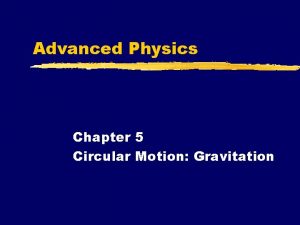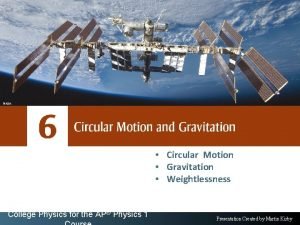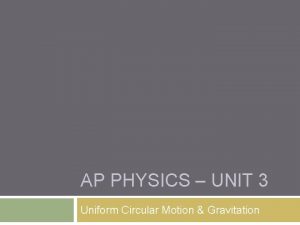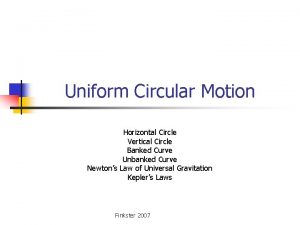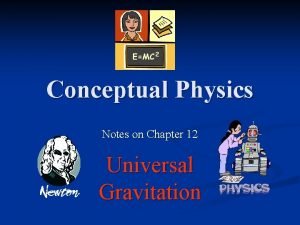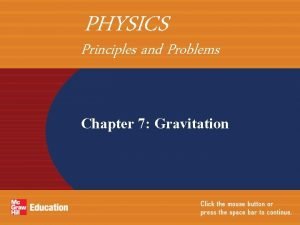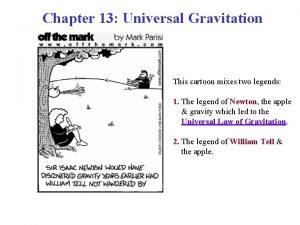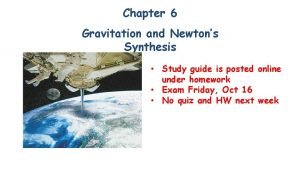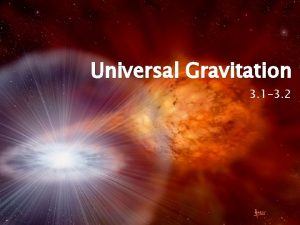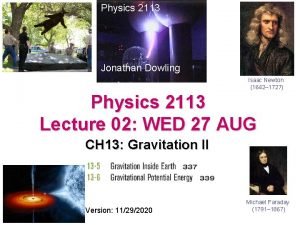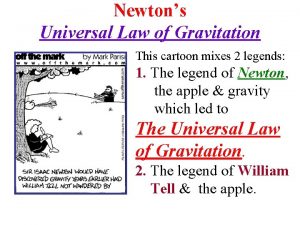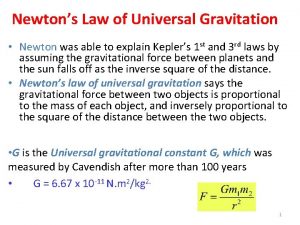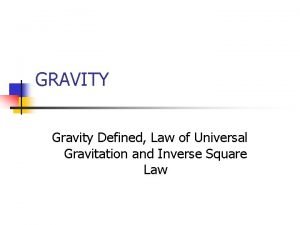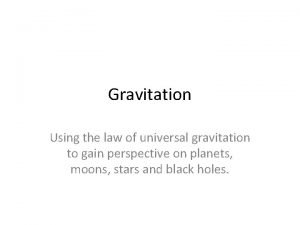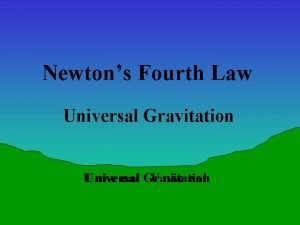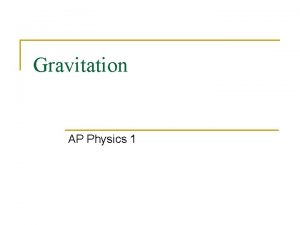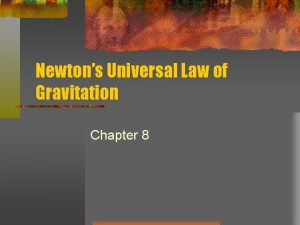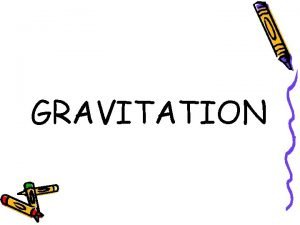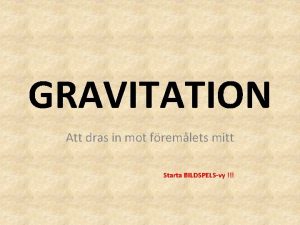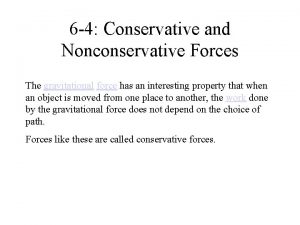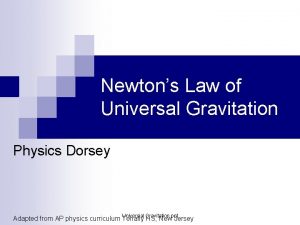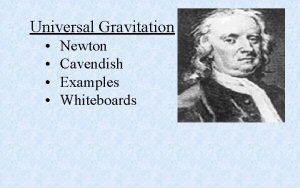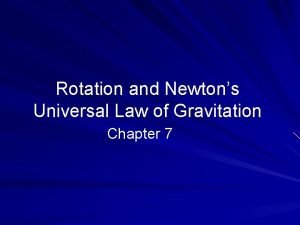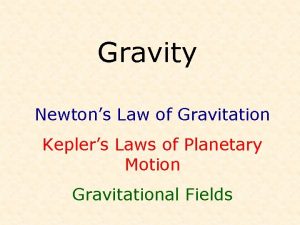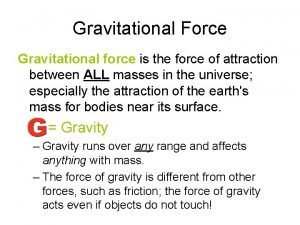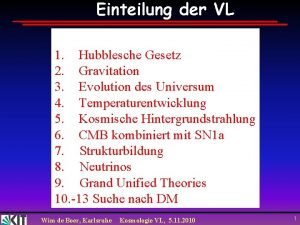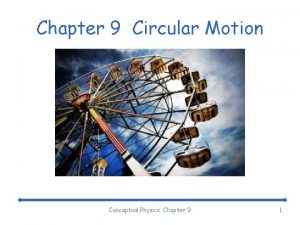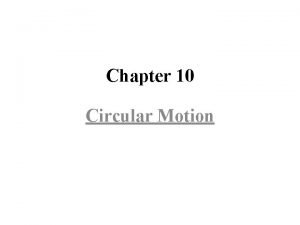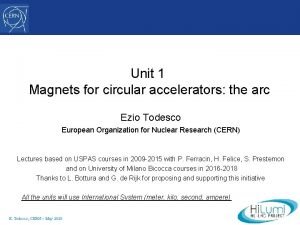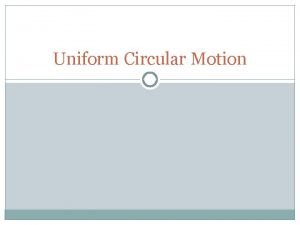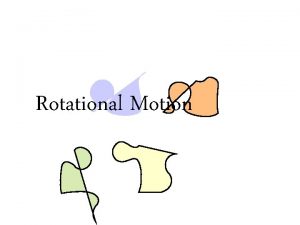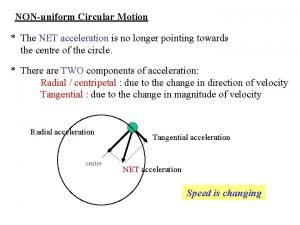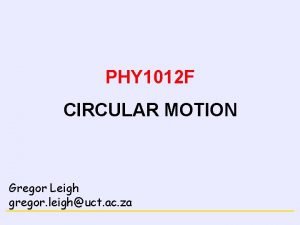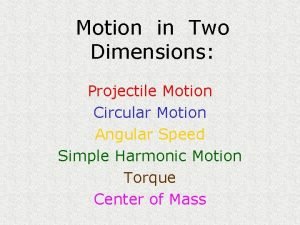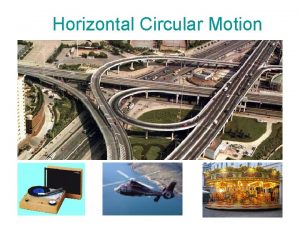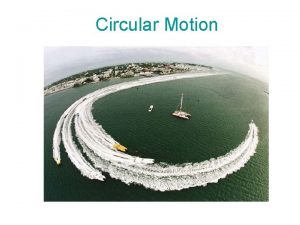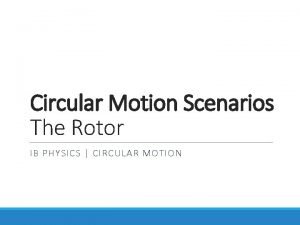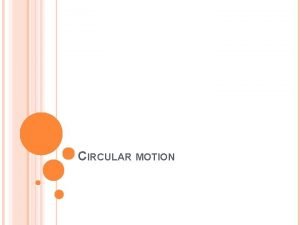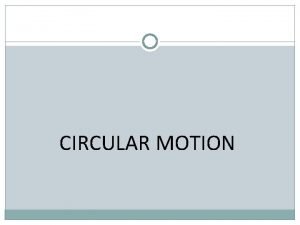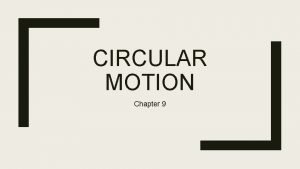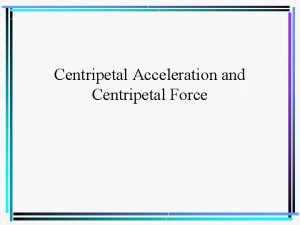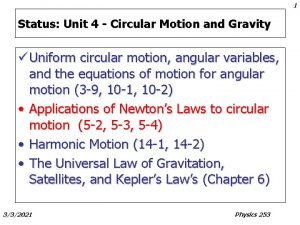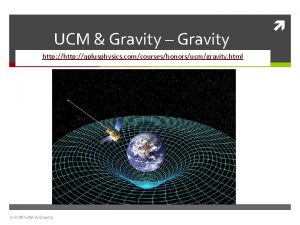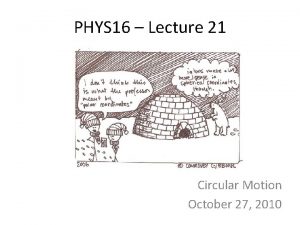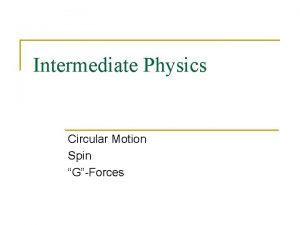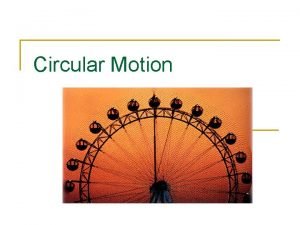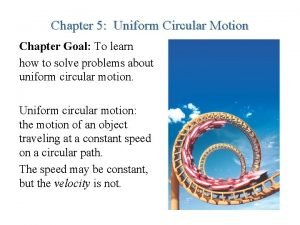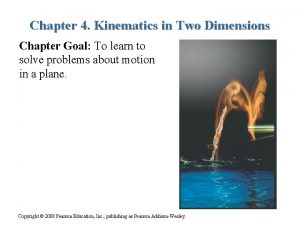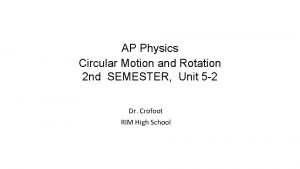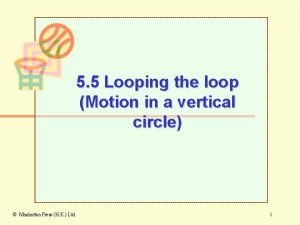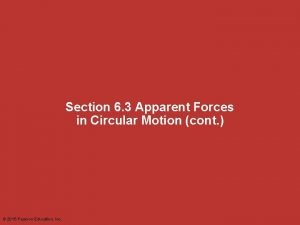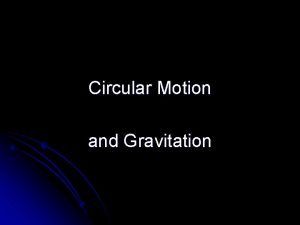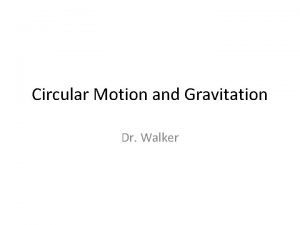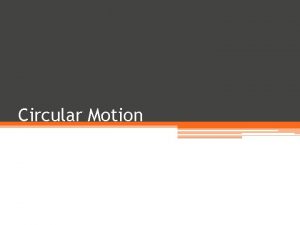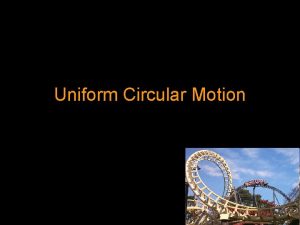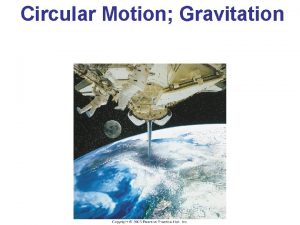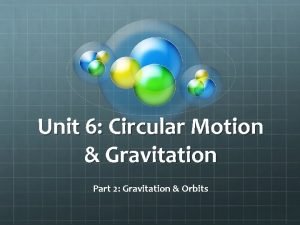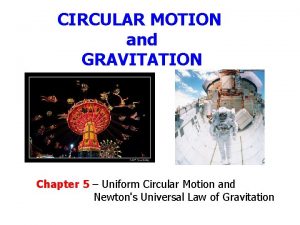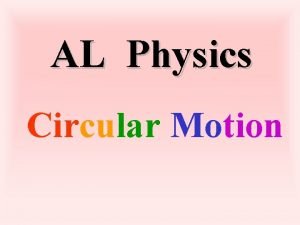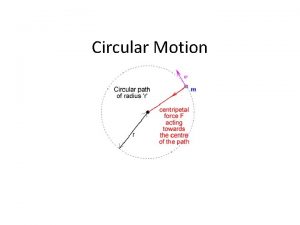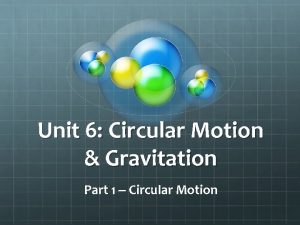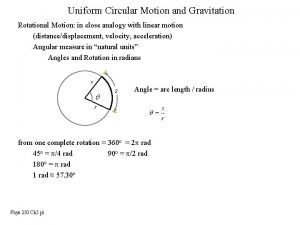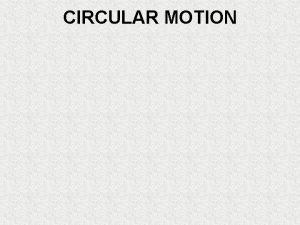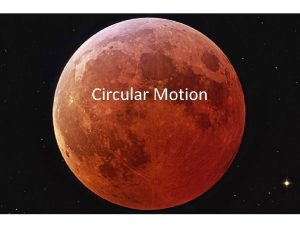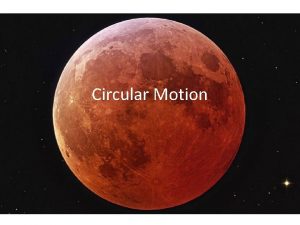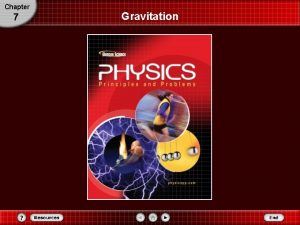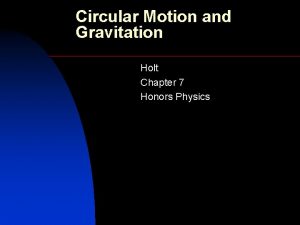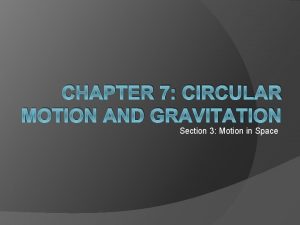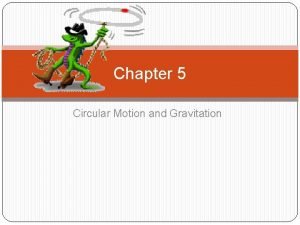CHAPTER 7 Circular Motion and Gravitation Circular Motion































































- Slides: 63

CHAPTER 7 Circular Motion and Gravitation

Circular Motion � Objectives: � 1. Solve problems involving centripetal acceleration. � 2. Solve problems involving centripetal force. � 3. Explain how the apparent existence of an outward force in circular motion can be explained as inertia resisting the centripetal force.

Centripetal Acceleration � Any object that revolves around a single axis experiences circular motion. �The axis of rotation is the line about which the object rotates. � Tangential speed (vt) is the speed of an object undergoing circular motion. �It is the speed of an object along a tangent line to the circular path that it follows. �When the tangential speed is constant, the object experiences uniform circular motion

Centripetal Acceleration � If an object is undergoing uniform circular motion, how can it accelerate? � The acceleration is due to the change in direction of the velocity. � Centripetal acceleration is acceleration directed toward the center of a circular path. � ac = vt 2 � r � Centripetal means “center seeking”

Concept Check � � A rope attaches a tire to an overhanging tree limb. A girl swinging on the tire has a centripetal acceleration of 3. 0 m/s 2. If the length of the rope is 2. 1 m, what is the girl's tangential speed? 2. 5 m/s

Concept Check � � As a young boy swings a yo-yo parallel to the ground above his head, the yo-yo has a centripetal acceleration of 250 m/s 2. If the yo-yo's string is 0. 50 m long, what is the yo-yo's tangential speed? 11 m/s

Concept Check � � A dog sits 1. 5 m from the center of a merry-go-round. The merry-go-round is set in motion, and the dog's tangential speed is 1. 5 m/s. What is the dog's centripetal acceleration? 1. 5 m/s 2

Concept Check � � A race car moving along a circular track has a centripetal acceleration of 15. 4 m/s 2. If the car has a tangential speed of 30. 0 m/s, what is the distance between the car and the center of the track? 58. 4 m

Tangential Acceleration � In circular motion, any acceleration due to a change in speed is dubbed tangential acceleration.

Centripetal Force � Centripetal force is the net force directed towards the center of an object's circular path. � Fc = mvt 2 � r � Any force or combination of forces can provide the net force.


Concept Check � � A 2. 10 m rope attaches a tire to an overhanging tree limb. A girl swinging on the tire has a tangential speed of 2. 50 m/s. If the magnitude of the centripetal force is 88. 0 N, what is the girl's mass? 29. 6 kg

Concept Check � � A bicyclist is riding at a tangential speed of 13. 2 m/s around a circular track. The magnitude of the centripetal force is 377 N, and the combination of the mass of the bicyclist and rider is 86. 5 kg. What is the track's radius? 40. 0 m

Concept Check � � � A dog sits 1. 50 m from the center of a merry-go-round and revolves at a tangential speed of 1. 80 m/s. If the dog's mass is 18. 5 kg, what is the magnitude of the centripetal force on the dog? 40. 0 N

Concept Check � � A 905 kg car travels around a circular track with a circumference of 3. 25 km If the magnitude of the centripetal force is 2140 N, what is the car's tangential speed? 35. 0 m/s

Centripetal Force � Centripetal force causes an object to maintain circular motion. �If the centripetal force is removed, the object will move in a straight line along its inertial path at the moment it was released. � If a ball is whirled in a circular path parallel to the ground and the string that it is attached to breaks, the ball will fly off horizontally in a direction tangent to the path. �The ball will then follow the parabolic path of a projectile.

Inertia and Centrifugal Force � The phenomena that occurs when an objects initializes circular motion and moves out from the center of the axis of rotation until it is stopped by an outside force is sometimes referred to as centrifugal (center fleeing) force. � This term is incorrect as the phenomena is actually caused by inertia, or the tendency of an object to continue moving in the same direction at the same speed. � NO CENTRIFUGAL FORCE!!!!!!

Newton's Law of Universal Gravitation � Objectives: � 1. Explain how Newton's law of universal gravitation accounts for various phenomena, including satellite and planetary orbits, falling objects, and the tides. � 2. Apply Newton's law of universal gravitation to solve problems.

Gravitational Force � Gravitational force is the mutual force of attraction between particles of matter. �The force that holds the planets in orbit around the sun and caused an apple to fall on Newton's head are one and the same. � Newton discovered that if an object were projected at just the right speed, the object would fall to Earth exactly as the Earth was curving away from it, ie, it would orbit the Earth. �The gravitational force would be just great enough to keep the object from following its inertial path.

NEWTON'S LAW OF UNIVERSAL GRAVITATION Fg = G m 1 m 2 2 r gravitational force = constant x mass 1 x mass 2 (distance b/t masses) 2

Newton's Law of Universal Gravitation �G is the constant of universal gravitation. � Newton never knew the value of G, but it has been found to be � G = 6. 673 x 10 -11 N▪ m 2 � kg 2 � Newton also discovered that the distance between an object exerting a gravitational force and the object experiencing a gravitational force is measured from the center of gravity of each object.


Gravitational Force � Gravitational forces act between all objects. � The acceleration of the larger object towards the smaller object is less apparent as acceleration is inversely proportional to mass. � The gravitation force between two orbiting bodies is a centripetal force and the bodies orbit the center of mass of the two-body system.

Concept Check � � What must be the distance between two 0. 800 kg balls if the magnitude of the gravitational force between them is 8. 92 x 10 -11 N? 0. 692 m

Concept Check � � Mars has a mass of about 6. 4 x 1023 kg, and its moon Phobos has a mass of about 9. 6 x 1015 kg. If the magnitude of the gravitational force between the two bodies is 4. 6 x 1015 N, how far apart are Mars and Phobos? 9. 4 x 106 m

Concept Check � Find the magnitude of the gravitational force a 66. 5 kg person would experience while standing on the surface of each of the following planets: � a. Earth m=5. 97 x 1024 kg; r = 6. 38 x 106 m � b. Mars m = 6. 42 x 1023 kg; r = 3. 40 x 106 m � c. Pluto m = 1. 25 x 1022 kg; r = 1. 20 x 106 m � a. 651 N � b. 246 N � c. 38. 5 N

Newton's Law of Gravitation and Tides � Tides occur as a result of the difference in the gravitational force of the moon at the Earth's center and at points on the surface. � Two high tides occur at points on the Earth in line with the moon. �On the side closer to the moon, the gravitational force is greater than at the Earth's center, so the water bulges outward towards the moon creating a high tide. �On the side farthest from the moon, the gravitational force is less, so the water bulges outward as well.

Cavendish Finds the Value of G and Earth's mass � 1798 -Henry Cavendish conducted an experiment that determined the value of G. � Once the value of G was known, Newton's law of gravitation was used to determine Earth's mass.

Gravity is a Field Force � � � Masses create a gravitational field in space. Gravitational force is an interaction between a mass and the gravitational field created by other masses. According to field theory, gravitational potential energy is stored in the gravitational field. Earth's gravitational field can be described by the gravitational field strength (g). g = Fg m

Gravitational Field Strength Equals Free-Fall Acceleration � The value for g is equal to the acceleration due to gravity. �They are not, however, the same thing. � Consider a mass hanging on a spring scale. �You are measuring the gravitational field strength. �The mass is at rest, so there is no acceleration. � Gravitational field strength rapidly decreases as distance from the Earth increases.

Weight Changes With Location Weight is equal to mass times gravitational field strength by Fg = Gm 1 m 2 r 2 � Thus, g = Fg = Gm 1 m 2 = G m 2 � m 1 r 2 Gravitational field strength depends on mass and distance from the object creating the gravitational field. Thus, your weight depends on location.

Weight Changes With Location � � As you get farther from Earth, your weight decreases. Your weight would be different on different planets because their masses and radii are different from the mass of Earth.

Gravitational Mass vs. Inertial Mass � Newton's 2 nd Law (F=ma) uses inertial mass �An object's tendency to resist acceleration � Newton's Law of Gravitation uses gravitational mass �relates how objects attract each other � It was not always accepted that these are the same mass. � We now know these are the same because free fall acceleration on Earth's surface is always the same.

Motion in Space � Objectives: � 1. Describe Kepler's laws of planetary motion. � 2. Relate Newton's mathematical analysis of gravitational force to the elliptical planetary orbits proposed by Kepler. � 3. Solve problems involving orbital speed and period.

Kepler's Laws � First Law: Each planet travels in an elliptical orbit around the sun, and the sun is at one of the focal points. � Second Law: An imaginary line drawn from the sun to any planet sweeps out equal areas in equal time intervals. � Third Law: The square of a planet's orbital period (T 2) is proportional to the cube of the average distance (r 3) between the planet and the sun. � T is the time it takes a planet to complete one full revolution. � r is the distance between the planet and the sun.

Kepler's Laws � Kepler's second law basically states that when a planet is closer to the sun, it travels faster. � Kepler's third law relates the orbital periods and distances of one planet to those of another planet. � The laws apply to all orbiting bodies (satellites, moons, etc).

Kepler's Laws and Newton's Laws � Newton verified his law of gravitation using Kepler's laws. � He demonstrated that Kepler's third law could be derived using his law of gravitation.

Quick Lab � You can mathematically show Kepler's third law can be derived from Newton's law of universal gravitation (assuming circular orbits. ) � To begin, recall that the centripetal force is provided by the gravitational force. � Set the equations for gravitational and centripetal force equal to one another and solve for vt 2. � Because speed equals distance divided by time and because the distance for one period is the circumference (2 r), vt = 2 r/ T.

Quick Lab � Square this value, subtract the squared value into your previous equation, and then isolate T 2. � How does your result relate to Kepler's third law?

Quick Lab � T 2 = (4 2) � (Gm) r 3

Period and Speed of an Object in Circular Orbit = 2�( r 3/Gm) �v = � [G ( m/r)] � Note that m is the mass of the object being orbited. � r is the distance between the centers of the two bodies. �T

Concept Check � Using Table 1 on p 250 of the text, find the orbital speed and period of a satellite traveling at a mean altitude of 361 km above Earth, Jupiter, and Earth's moon. � Earth: 7. 69 x 103 m/s; 5. 51 x 103 s � Jupiter: 4. 20 x 104 m/s; 1. 08 x 104 s � moon: 1. 53 x 103 m/s; 8. 63 x 103 s

Concept Check � � At what distance above the Earth would a satellite have a period of 125 min? 1. 90 x 106 m

Weight and Weightlessness � Weight is the magnitude of the force due to gravity. � When you step on a scale, it measures the downward force applied to it. �From Newton's third law, we know the normal force of the scale equals the downward force applied to it. �The scale reading is equal to the normal force acting on you.

Weight and Weightlessness � When you are standing on a scale in an elevator and the elevator is at rest, the scale reads your weight. �When the elevator accelerates downward, the normal force will be smaller and the scale will read less than your weight. �When the elevator's acceleration is equal to free-fall acceleration, the scale will read zero and you will have no normal force acting on you. �Both you and the elevator are falling with free-fall acceleration. �Apparent weightlessness.

Weight and Weightlessness � Astronauts in orbit experience apparent weightlessness. �The shuttle is accelerating at the same rate as the astronauts. �Force due to gravity keeps the shuttle and astronauts in orbit, but the astronauts feel weightless because there is no normal force acting on them. � Actual weightlessness only occurs in deep space.

Torque and Simple Machines � Objectives: � 1. Distinguish between torque and force. � 2. Calculate the magnitude of a torque on an object. � 3. Identify the six types of simple machines. � 4. Calculate the mechanical advantage of a simple machine.

Rotational Motion � Rotational motion is the motion of a rotating rigid object that spins about its center of mass. � Objects can exhibit multiple types of motion at the same time, but they can be separated analyzed separately.

Torque � Torque is a quantity that measures the ability of a force to rotate an object about some axis. � The farther the force is from the axis of rotation, the easier it is to rotate the object and the more torque is produced. � The perpendicular distance from the axis of rotation to a line drawn along the direction of the force is called the lever arm. � Forces do not have to be perpendicular to an object to cause the object to rotate.


Torque � When the angle is less than 90 , the object will not rotate as easily. � T = Fd sinӨ � Torque = force x lever arm!! � Ө is the angle between the applied force and the lever. � Units of torque are N▪m



Torque � Torque is a vector and, as thus, has a magnitude and a direction. � Torque is positive if the rotation is counterclockwise and negative if it is clockwise. � Net torque can be found by finding the sum of the individual torques acting on an object.

Concept Check � � Find the magnitude of the torque produced by a 3. 0 N force applied to a door at a perpendicular distance of 0. 25 m from the hinge. 0. 75 N▪m

Concept Check �A simple pendulum consists of a 3. 0 kg point mass hanging at the end of a 2. 0 m long light string that is connected to a pivot point. � a. Calculate the magnitude of the torque (due to gravitational force) around this pivot point when the string makes a 5. 0˚ angle with the vertical. � b. Repeat this calculation for an angle of 15. 0˚. � a. 5. 1 N▪m � b. 15 N▪m

Concept Check � � If the torque required to loosen a nut on the wheel of a car has a magnitude of 40. 0 N▪m, what minimum force must be exerted by a mechanic at the end of a 30. 0 cm wrench to loosen the nut? 133 N

Simple Machines �A machine is any device that transmits or modifies force, usually by changing the force applied to an object. � All machines are combinations or modifications of six simple machines �lever �pulley �inclined plane �wheel and axle �wedge �screw


Mechanical Advantage � Mechanical advantage is the comparison of the output force to the input force. � MA = output force = Fout � input force Fin � When using a lever (friction disregarded) � Tin = Tout � Fin din = Fout dout � � MA = Fout = din Fin dout


Machines Can Alter Force and Distance Moved � Mechanical energy is conserved (in the absence of friction) by machines as well. �Work will remain constant. � When using an inclined plane to move an object, the force required is decreased but the distance moved is increased.

Efficiency � Real machines are not frictionless and some mechanical energy is dissipated. � Efficiency relates the useful work output to the work input. � eff = Wout � Win � If the machine is frictionless, the efficiency is 1. � All real machines have an efficiency of less than 1.
 Chapter 5 circular motion gravitation
Chapter 5 circular motion gravitation Martin kirby physics
Martin kirby physics Unit 3 circular motion and gravitation
Unit 3 circular motion and gravitation Horizontal circle and vertical circle
Horizontal circle and vertical circle Conceptual physics chapter 13 universal gravitation
Conceptual physics chapter 13 universal gravitation Chapter 7 physics study guide answers
Chapter 7 physics study guide answers 13 universal law
13 universal law Gravitation and newton's synthesis
Gravitation and newton's synthesis Explain newton’s universal law of attraction/gravitation.
Explain newton’s universal law of attraction/gravitation. Gauss law in gravitation
Gauss law in gravitation Cartoon law of universal gravitation
Cartoon law of universal gravitation The laws of gravity
The laws of gravity Newton's law of gravitation
Newton's law of gravitation Kinetic energy and gravity
Kinetic energy and gravity Gravity
Gravity Minimum speed for vertical circular motion
Minimum speed for vertical circular motion Universal gravitation law
Universal gravitation law Universal law of gravitation calculator
Universal law of gravitation calculator What is newtons fourth law
What is newtons fourth law Newton's universal law of gravitation ap physics 1
Newton's universal law of gravitation ap physics 1 Newton's universal law of gravitation simplified
Newton's universal law of gravitation simplified Gravitation is a natural phenomenon where
Gravitation is a natural phenomenon where Gravitation enhet
Gravitation enhet Is gravitational force conservative or non-conservative why
Is gravitational force conservative or non-conservative why Law of universal gravitation ppt
Law of universal gravitation ppt Law of universal gravitation kid definition
Law of universal gravitation kid definition Universal law of gravitation
Universal law of gravitation Gravitation
Gravitation Effects of gravitational force
Effects of gravitational force Gravitation scheinkraft
Gravitation scheinkraft Conceptual physics chapter 9 circular motion answers
Conceptual physics chapter 9 circular motion answers Chapter 10 circular motion
Chapter 10 circular motion Chapter 2 motion section 1 describing motion answer key
Chapter 2 motion section 1 describing motion answer key The main difference between speed and velocity involves
The main difference between speed and velocity involves Section 1 describing motion
Section 1 describing motion Proportion hairstyle
Proportion hairstyle Relativistic circular motion
Relativistic circular motion Uniform circular motion implies
Uniform circular motion implies Circular motion formula
Circular motion formula Net acceleration in circular motion
Net acceleration in circular motion Learning objectives for newton's laws of motion
Learning objectives for newton's laws of motion Normal force at top of loop
Normal force at top of loop Circular motion on banked road
Circular motion on banked road Circular motion examples
Circular motion examples Rotor circular motion
Rotor circular motion Circular motion formula
Circular motion formula Circular motion formula
Circular motion formula Circular motion definition
Circular motion definition Tension in a circular motion
Tension in a circular motion Non uniform circular motion examples
Non uniform circular motion examples Aplusphysics ucm-circular motion answers
Aplusphysics ucm-circular motion answers Acceleration in circular motion
Acceleration in circular motion Circular motion
Circular motion Recipe language
Recipe language Maximum velocity in vertical circular motion
Maximum velocity in vertical circular motion Circular motion conceptual questions
Circular motion conceptual questions How to solve circular motion problems
How to solve circular motion problems Dynamics of uniform circular motion
Dynamics of uniform circular motion Si unit of circular motion
Si unit of circular motion Ap physics circular motion
Ap physics circular motion Loop aircraft motion
Loop aircraft motion Circular motion is one dimensional or two dimensional
Circular motion is one dimensional or two dimensional Acceleration vector projectile motion
Acceleration vector projectile motion Physics textbook
Physics textbook
